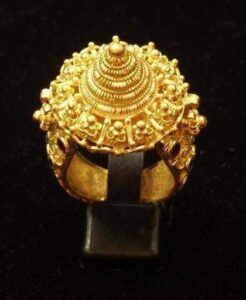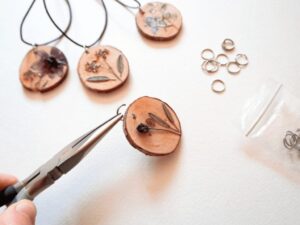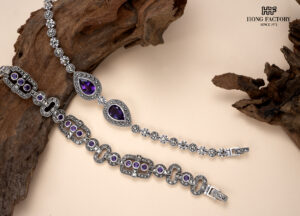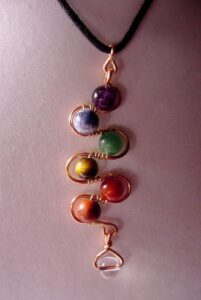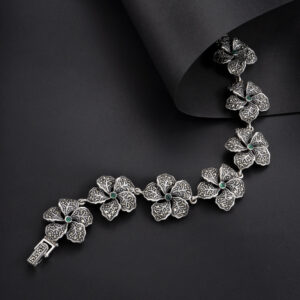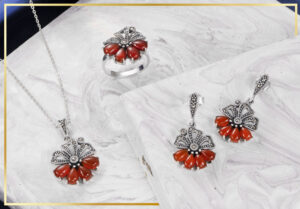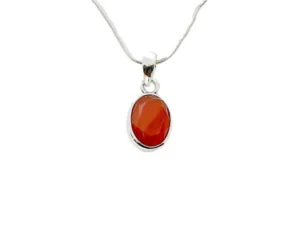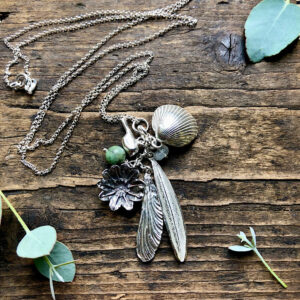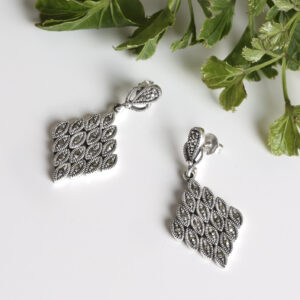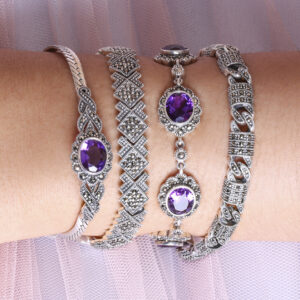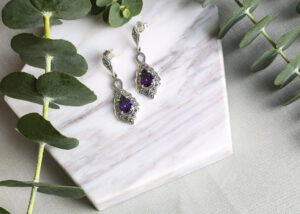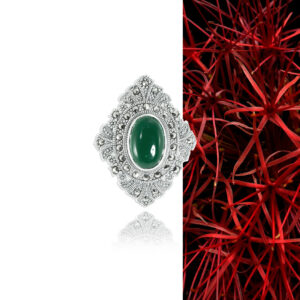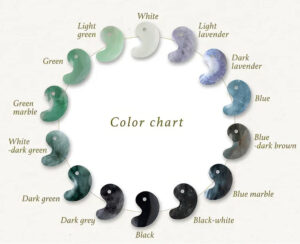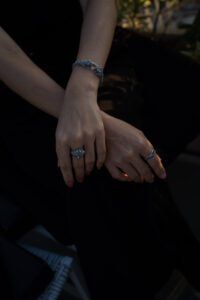
Ring Ideas for Songkran
Rings are small but powerful accessories that carry symbolism, fashion, and personal expression. During Songkran, Thailand’s joyful water festival and New Year celebration, wearing rings can represent unity, blessings, protection, and even spiritual alignment. Whether you’re attending a temple ceremony, joining a water parade, or spending time with family, the right ring can add depth and flair to your festive look. In this article, we explore thoughtfully curated ring ideas for Songkran, suitable for traditional, modern, or spiritual celebrations. From symbolic stones to Thai cultural motifs, these rings will help you connect more meaningfully with the spirit of Songkran.
Ring Ideas for Songkran

Why Wear Rings for Songkran?
Rings are not only visually striking but also rich in cultural and spiritual meaning. In Thai tradition and Buddhism, rings often carry talismanic or ritualistic value. They may also serve as beautiful mementos or family heirlooms.
Wearing rings during Songkran can:
- Symbolize new beginnings and blessings
- Offer spiritual protection or good fortune
- Elevate traditional or modern Thai outfits
- Celebrate cultural identity and personal style
- Serve as thoughtful Songkran gifts
1. Traditional Thai Pattern Rings
Celebrate heritage with rings inspired by Thai patterns and architecture.
Look for designs featuring:
- The Kanok pattern
- Lotus flower motifs
- Lanna-inspired swirls or temple roof curves
Often crafted in gold or silver, these rings look stunning with traditional Thai attire like silk blouses and sinh skirts.
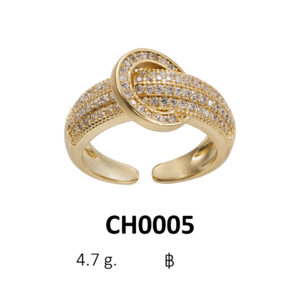
2. Gold Bands for Prosperity and Purity
Gold is traditionally worn during Songkran for its association with wealth, good luck, and positive energy.
Styles to try:
- Plain gold bands for understated elegance
- Carved rings with temple motifs
- Delicate gold rings with engraved blessings
Ideal for both men and women, and suitable for formal family ceremonies.

3. Crystal and Gemstone Rings for Energy and Intention
Crystals are widely used for their metaphysical properties — and wearing them as rings helps direct that energy through your hands.
Best gemstones for Songkran:
- Amethyst: for peace and clarity during transitions
- Citrine: for joy, abundance, and celebration
- Rose Quartz: for love and compassion
- Tiger’s Eye: for courage and protection
Choose single-stone rings, cluster styles, or stacking sets for visual variety.
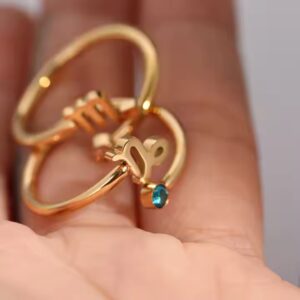
4. Zodiac and Birthstone Rings
Wearing your Thai zodiac sign or birthstone is a powerful way to connect with personal identity during the New Year.
Consider:
- Rings with engraved zodiac animals
- Birthstone rings with protective silver or gold settings
- Dual birthstone designs for couples or families
Great for gifting and sharing between generations.
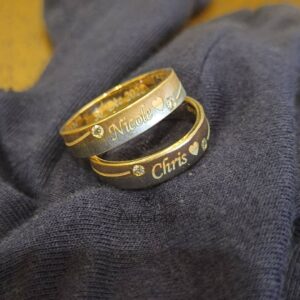
5. Matching Couple Rings for Love and Unity
Songkran is a time for family and relationships. Matching rings can symbolize a shared journey into the New Year.
Popular pairings:
- Lotus flower and leaf sets
- Heart-shaped stone rings
- Thai script engravings (e.g.,)
Select subtle and elegant designs that suit both partners.
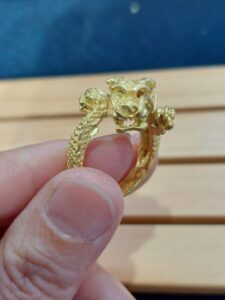
6. Thai Amulet and Protective Symbol Rings
Many Thais wear rings featuring protective symbols to honor spiritual traditions and seek blessings.
Options include:
- Rings with yantra symbols (ยันต์)
- Buddha image rings (พระ)
- Ruesi or monk faces for wisdom
Choose these rings in carved silver or mixed metal finishes for an authentic touch.
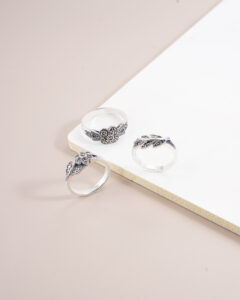
7. Floral-Inspired Rings for Joy and Renewal
Flowers are central to Songkran, especially jasmine, which symbolizes purity and respect. Floral rings echo the beauty of Thai New Year traditions.
Great picks:
- White flower enamel rings
- Petal-motif filigree designs
- Floral gemstone cluster rings
These are perfect for temple ceremonies or Songkran garden parties.
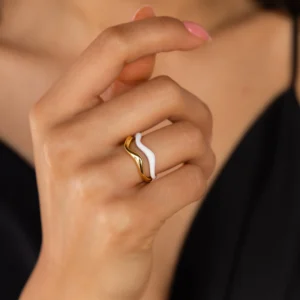
8. Stackable Rings for Modern Songkran Style
For a trendier look, stackable rings let you express color, shape, and mood — all in one hand.
Styling ideas:
- Mix gemstones, metals, and symbols
- Alternate slim gold bands with colorful crystal rings
- Use one statement piece with smaller accents
Ideal for younger generations celebrating Songkran in casual or fusion attire.
9. DIY and Custom Engraved Rings
Personalized rings carry intention and meaning. Custom engraving adds sentimental value for Songkran gifts or keepsakes.
What to engrave:
- A meaningful date (New Year, birthdate)
- A spiritual phrase or blessing
- Initials of loved ones
Make them in sterling silver, gold vermeil, or stainless steel for long-lasting wear.
10. Sustainable and Handmade Artisan Rings
Celebrate local craftsmanship by wearing handmade rings from Thai artisans. These pieces often carry cultural stories and ethical value.
Look for:
- Rings made with recycled metals
- Hand-set local stones (e.g., garnet, zircon)
- Traditional casting or hammering techniques
Support local makers and wear something truly one-of-a-kind.
How to Wear and Pair Rings for Songkran
1. Match Ring Style to Occasion:
- Use traditional or gemstone rings for temple visits
- Choose fun floral or stacked designs for casual or festive events
2. Coordinate with Your Outfit:
- Pair gold with warm tones, silver with cooler colors
- Mix metals for a modern touch
3. Balance with Other Jewelry:
- If your rings are bold, keep other accessories minimal
- Let one ring shine as your statement piece
4. Ensure Comfort for Festivities:
- Avoid oversized or heavy rings during water play
- Choose adjustable styles for swelling from heat or activity
5. Cleanse or Bless Before Wearing:
- Clean your gemstone rings with water or moonlight
- Visit a temple to have rings blessed for the year ahead
Rings for Songkran aren’t just about beauty – they’re about meaning, memory, and personal expression. Whether you’re drawn to cultural heritage, spiritual symbolism, or simply want to sparkle with your style, there’s a ring for every moment of the celebration. From engraved gold bands to crystal-studded creations, let your Songkran ring reflect your hopes, your history, and your heart. This Thai New Year, wear more than an accessory – wear your story on your hand.

Spiritual Jewelry Ideas for Travel
Spiritual jewelry offers a unique way to combine meaningful symbolism with stylish design, making it an ideal accessory for travelers seeking protection, inspiration, and connection during their journeys. Whether you’re embarking on a pilgrimage, exploring new cultures, or simply looking for a deeper sense of purpose while traveling, spiritual jewelry can serve as a constant reminder of your intentions and beliefs. Below are some spiritual jewelry ideas for travel that are both beautiful and meaningful.
Spiritual Jewelry Ideas for Travel
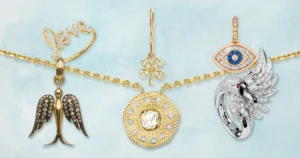
Symbolic Jewelry for Protection
Traveling often comes with uncertainties, and many spiritual jewelry pieces are designed to offer protection and peace of mind.
- St. Christopher Pendants: St. Christopher is the patron saint of travelers, and wearing his medallion is believed to provide safety and guidance on journeys. These pendants often feature intricate engravings and can be worn as necklaces or bracelets.
- Evil Eye Jewelry: Popular in many cultures, the evil eye symbol is thought to ward off negative energy and protect the wearer from harm. Opt for a delicate evil eye pendant or bracelet for a stylish yet protective accessory.
- Hamsa Hand Necklaces: The Hamsa hand is another powerful symbol of protection, often associated with deflecting negative energy and bringing good fortune. It’s commonly crafted in gold or sterling silver with gemstone accents.
- Guardian Angel Charms: Angel-themed jewelry, such as necklaces or bracelets featuring angel wings or figures, can serve as a comforting reminder of divine protection during your travels.
Cultural and Religious Spiritual Jewelry
For those who enjoy immersing themselves in the spiritual traditions of different cultures, cultural jewelry offers both beauty and depth.
- Balinese Amulets: Balinese jewelry often incorporates symbols from Hinduism, such as lotus flowers (representing purity) or Om symbols (signifying universal connection). Silver amulets are especially popular for their spiritual significance and craftsmanship.
- Tree of Life Pendants: A symbol found in many cultures, the tree of life represents growth, strength, and interconnectedness. These pendants are often adorned with gemstones like peridot or abalone shell to enhance their natural beauty.
- Celtic Crosses: For those inspired by Celtic spirituality, necklaces featuring the intricate patterns of Celtic crosses can symbolize faith and eternal life.
- Camino de Santiago Shell Jewelry: The scallop shell is a traditional symbol associated with the Camino de Santiago pilgrimage in Spain. Necklaces or bracelets featuring this motif are perfect for travelers seeking spiritual renewal.jewellery wholesale thailand.
Gemstone Jewelry for Energy and Healing
Gemstones have long been revered for their metaphysical properties, making them an excellent choice for spiritual travelers.
- Amethyst Necklaces: Known for its calming energy and ability to enhance intuition, amethyst is ideal for travelers seeking inner peace during their journeys.
- Moonstone Pendants: Associated with new beginnings and emotional balance, moonstone is perfect for those embarking on transformative trips.
- Tourmaline Bracelets: This stone is believed to provide protection against negative energy while promoting grounding and peace—perfect for adventurers exploring unfamiliar places.
- Quartz Crystal Jewelry: Often called the “master healer,” quartz is thought to amplify positive energy and provide clarity. A quartz pendant or ring can help you stay focused on your intentions while traveling.
Chakra Jewelry for Balance
Chakra jewelry is designed to align the body’s energy centers (chakras), promoting balance and harmony during your travels.
- Chakra Stone Necklaces: These necklaces feature seven colorful gemstones corresponding to each chakra. They’re both visually striking and spiritually significant.
- Bracelets with Chakra Beads: Stretch bracelets adorned with chakra stones are easy to wear daily and serve as reminders to stay grounded and balanced.
- Amethyst Chakra Pendants: Combining the calming properties of amethyst with chakra alignment makes these pendants ideal for meditation or mindfulness practices on the go.
Personalized Spiritual Jewelry
Customizable jewelry allows you to create pieces that reflect your unique journey and intentions.
- Engraved Coordinates Necklaces: Personalize a bar necklace with the coordinates of a meaningful location, such as your favorite travel destination or a place that holds special memories.
- Initials or Names on Pendants: Add initials or names of loved ones to keep them close to your heart while traveling.
- Birthstone Jewelry: Incorporate your birthstone into a necklace or bracelet for a personal touch that also connects you to your astrological sign.
Nature-Inspired Spiritual Jewelry
Nature-inspired designs celebrate the beauty of the earth while fostering a sense of connection to the natural world.
- Shell Pendants: Perfect for beach lovers, shell necklaces evoke memories of seaside escapes while symbolizing protection and renewal.
- Floral Motifs: Jewelry featuring flowers like lotus blossoms or daisies can represent purity, growth, and new beginnings.
- Animal Totem Jewelry: Pieces featuring animals like birds (freedom), turtles (longevity), or butterflies (transformation) carry deep symbolic meanings tied to nature.
Practical Spiritual Accessories
Some spiritual jewelry combines style with functionality, making them practical companions for travel.
- Travel Safety Whistles: These necklaces feature small whistles engraved with protective symbols like crosses or scallop shells. They’re both meaningful talismans and useful tools in emergencies.
- Rosary Beads Necklaces: Rosaries serve as both prayer tools and elegant accessories. Opt for designs in gold or silver with multicolored beads for added beauty.
- Charm Bracelets with Travel Themes: Create a bracelet featuring charms like airplanes, compasses, or globes alongside spiritual symbols such as angels or Hamsa hands.
Tips for Choosing Spiritual Jewelry for Travel
When selecting spiritual jewelry for travel, consider these factors:
- Symbolic Meaning: Choose pieces that align with your personal beliefs or intentions. Whether it’s protection, healing, or mindfulness, ensure the symbolism resonates with you.
- Material Durability: Opt for high-quality materials like sterling silver or gold-plated designs that can withstand wear during travel.
- Lightweight Designs: Select lightweight pieces that are comfortable to wear throughout long days of exploration.
- Versatility: Look for jewelry that complements multiple outfits so you can pack light without sacrificing style.
- Cultural Sensitivity: If purchasing jewelry from another culture, take time to understand its significance to ensure respectful use.
Spiritual jewelry offers more than just aesthetic appeal—it serves as a meaningful companion on your travels by providing protection, inspiration, and connection. From protective talismans like St. Christopher pendants and evil eye charms to gemstone-adorned chakra necklaces promoting balance, there’s something for every traveler’s spiritual journey. By choosing pieces that resonate with your intentions and values, you can carry positive energy wherever you go while honoring diverse traditions along the way. Let your spiritual jewelry be both a stylish accessory and a source of strength as you explore the world!
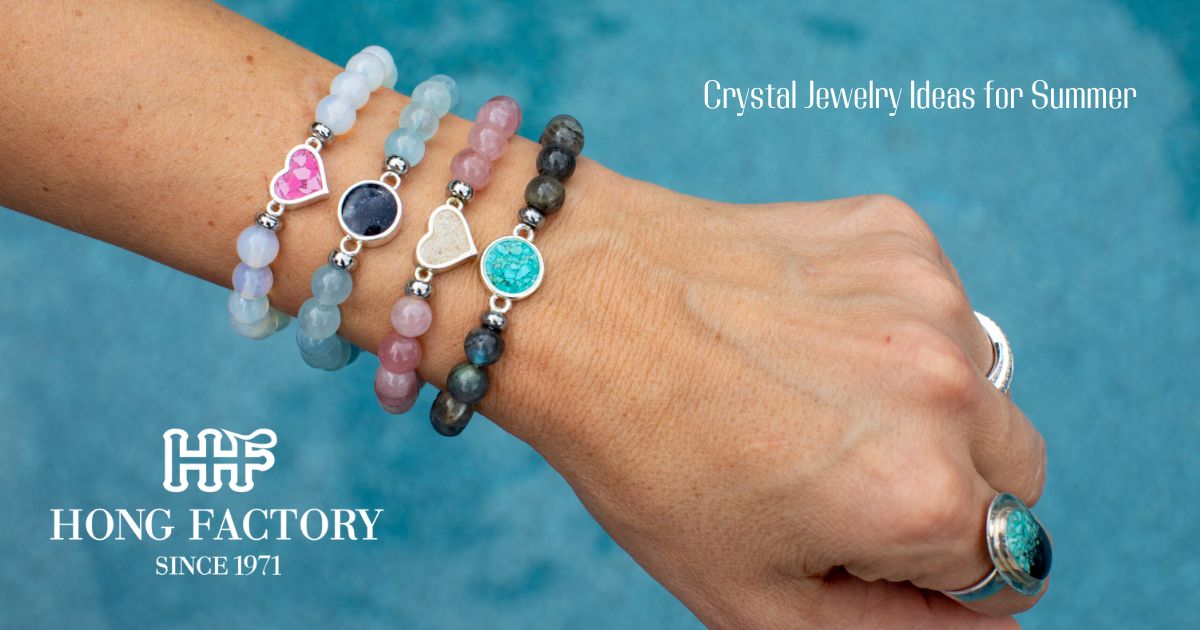
Crystal Jewelry Ideas for Summer
Whether you’re lounging on the beach, exploring the outdoors, or attending a festival, crystal jewelry offers both aesthetic charm and energetic benefits. These pieces aren’t just decorative they’re intentional, often worn for their healing properties, emotional balance, and connection to nature.
In this article, we explore the best crystal jewelry ideas for summer, from delicate pendants to vibrant bracelets, to help you express your style and energy all season long.
Crystal Jewelry Ideas for Summer
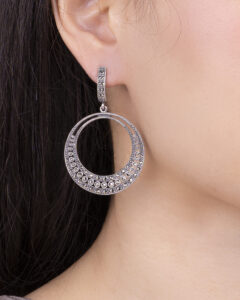
Why Choose Crystal Jewelry for Summer?
Crystals have been used for centuries to support wellness, focus, and inner peace. During summer, when energy is vibrant and active, crystal jewelry helps amplify your intentions and complement your seasonal mood.
Benefits of wearing crystal jewelry:
- Supports emotional and physical wellness
- Adds color and meaning to your outfits
- Creates a natural, earthy look for summer style
Let’s explore the most popular and impactful crystal jewelry styles for the season.
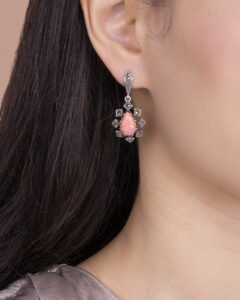
1. Rose Quartz for Love and Compassion
Soft pink and filled with gentle energy, rose quartz is a summer favorite. It promotes love, emotional healing, and self-compassion.
Jewelry ideas:
- Heart-shaped rose quartz pendant
- Beaded stretch bracelets
- Rose quartz rings with minimalist settings
Pair it with light fabrics and soft colors for a romantic summer vibe.
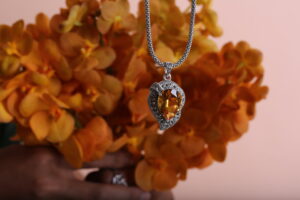
2. Citrine for Joy and Abundance
Known as the “sunshine stone,” citrine radiates positivity and confidence. It’s perfect for enhancing your mood and manifesting abundance.
Best styles:
- Citrine drop earrings
- Dainty layered necklaces
- Sunburst citrine rings
Citrine is perfect for summer adventures, sunny days, and goal-setting rituals.

3. Amethyst for Calm and Clarity
Even in the busy summer season, we all need calm. Amethyst supports peace of mind, restful sleep, and clear thinking.
Wear amethyst as:
- Crystal point pendants
- Raw amethyst stud earrings
- Amethyst bead bangles
Amethyst pairs beautifully with cool tones and is ideal for evening events or meditative summer moments.

4. Turquoise for Travel and Protection
Turquoise is both fashionable and symbolic, long used for protection and safe travel. Its bright blue hue also complements summer palettes.
Style suggestions:
- Boho turquoise chokers
- Turquoise inlay cuffs
- Statement turquoise rings
Great for beachwear, festivals, or road trips where you want grounding energy and bold style.

5. Clear Quartz for Amplifying Intentions
Clear quartz is a powerful all-purpose crystal. It enhances clarity and amplifies other stones’ energy, making it a great base for any summer jewelry set.
Try these designs:
- Crystal point pendants on long chains
- Layered quartz necklaces
- Stackable clear quartz bracelets
Clear quartz works with any outfit and can be dressed up or down.

6. Amazonite for Communication and Peace
A beautiful green-blue stone, amazonite supports open communication, especially helpful during travel or group gatherings.
Best pieces:
- Amazonite bead necklaces
- Bar bracelets with polished stones
- Adjustable rings with oval cabochons
Amazonite’s fresh hue adds a calming and stylish touch to summer neutrals.
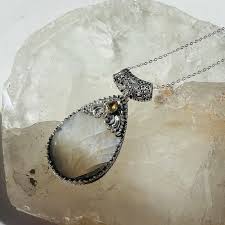
7. Moonstone for Intuition and Feminine Energy
Moonstone glows with a soft shimmer and supports intuition, inner strength, and emotional balance — especially in phases of change.
Great options:
- Moonstone drop earrings
- Crescent moon pendants
- Delicate moonstone stacking rings
This ethereal stone pairs well with flowy dresses and soft summer evenings.
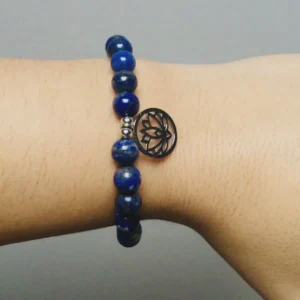
8. Lapis Lazuli for Confidence and Expression
Deep blue lapis lazuli empowers confidence and authentic expression. It’s bold, elegant, and packed with presence.
Jewelry ideas:
- Lapis pendant necklaces with gold trim
- Geometric lapis earrings
- Mixed gemstone cuffs featuring lapis
Wear lapis when presenting, performing, or meeting new people this summer.
9. Carnelian for Motivation and Creativity
With its fiery orange-red color, carnelian energizes creativity and courage. It’s a great companion for artists, performers, or those embracing summer goals.
Include in:
- Chunky carnelian bracelets
- Pendant necklaces with polished stones
- Matching ring and earring sets
This stone pops with vibrant summer colors like yellow, coral, and white.

10. Mixed Crystal Sets for Everyday Versatility
Can’t pick just one? A mixed crystal jewelry set lets you enjoy the benefits and beauty of multiple stones.
Components to include:
- A bracelet stack with 3–5 types of crystals
- A pendant necklace with a crystal cluster
- Earrings with alternating stones
Mixing crystals lets you personalize your energy each day and pair them with every outfit.
Tips for Wearing Crystal Jewelry in Summer
1. Choose Skin-Friendly Settings
Opt for hypoallergenic and non-tarnish metals to prevent irritation in the heat.
2. Cleanse Your Crystals
Sunlight, water, or smudging can refresh your crystals’ energy — especially after travel or long days.
3. Match Crystals to Your Intentions
Select stones based on what you want to attract or support during the season.
4. Layer for Style and Impact
Stack bracelets or layer necklaces for a dynamic, fashion-forward look.
Crystal jewelry is more than a summer trend — it’s a way to combine style with purpose. Whether you’re drawn to soft moonstone, radiant citrine, or grounding turquoise, there’s a piece that resonates with your summer vibe. Let your accessories reflect your energy. Embrace the season with crystal pieces that shine, heal, and inspire — all while elevating your everyday style.

Fashion Jewelry Ideas for Songkran
Songkran, Thailand’s vibrant New Year festival, is a time of joy, renewal, and cultural celebration. Known for its iconic water fights and traditional rituals, Songkran also provides an opportunity to showcase unique fashion and accessories. Jewelry plays a significant role in enhancing festive outfits, blending tradition with modern trends. This article explores fashion jewelry ideas perfect for Songkran, focusing on styles that are practical, symbolic, and on-trend for 2025.
Fashion Jewelry Ideas for Songkran
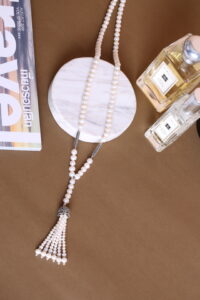
1. Water-Resistant Jewelry
Given the water-centric nature of Songkran, choosing water-resistant jewelry is essential. Opt for materials like stainless steel, gold plating, or resin that can withstand splashes without tarnishing or losing their shine. Popular options include:
- Gold-Plated Bangles: Lightweight and durable, these add a touch of elegance to any outfit.marcasite jewelry.
- Stainless Steel Necklaces: Perfect for layering with pendants or charms.
- Silicone Bracelets: A playful and colorful choice that’s both practical and stylish.
These pieces ensure you can enjoy the festivities without worrying about damaging your accessories.
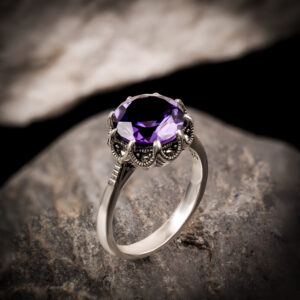
2. Zodiac-Inspired Jewelry
Astrological jewelry is a meaningful way to personalize your Songkran look. Incorporate zodiac symbols or birthstones into your accessories to reflect your personality or that of loved ones. For example:
- Constellation Pendants: Featuring your zodiac sign’s star pattern in delicate designs.
- Birthstone Rings: Highlighting gemstones associated with each zodiac sign, such as aquamarine for Pisces or ruby for Cancer.
- Double Zodiac Charms: Combining your sign with a loved one’s for a thoughtful touch.
Zodiac jewelry aligns beautifully with Songkran’s themes of renewal and cosmic alignment.

3. Traditional Thai Jewelry
Celebrate the cultural essence of Songkran by incorporating traditional Thai jewelry into your ensemble. These pieces often feature intricate craftsmanship and symbolic motifs:
- Gold Thai Necklaces: Adorned with floral or geometric patterns that reflect Thai heritage.
- Chut Thai Accessories: Complementing traditional silk outfits with delicate gold or silver earrings.
- Naga-Inspired Designs: Representing protection and prosperity through serpent-like motifs.
These timeless pieces honor the festival’s roots while adding sophistication to your attire.
4. Layered Necklaces
Layered necklaces remain a top trend in 2025, offering versatility and style. For Songkran, mix different lengths and materials to create depth:
- Pair chunky gold chains with dainty silver ones for a modern twist.
- Add pendants featuring water droplets or lotus flowers to reflect Songkran’s themes of cleansing and renewal.
- Incorporate colorful gemstone beads to infuse vibrancy into your look.
Layered necklaces allow you to experiment with textures and styles while staying on-trend.
5. Statement Earrings
Statement earrings are perfect for making an impact during Songkran celebrations. Bold designs can elevate even the simplest outfit:
- Oversized Hoops: Add drama while remaining lightweight and comfortable.
- Floral Drop Earrings: Reflecting the beauty of nature in intricate designs.
- Asymmetrical Styles: Mixing shapes or colors for an artistic flair.
Choose earrings made from lightweight materials like acrylic or resin to ensure comfort throughout the day.
6. Colorful Gemstone Jewelry
Vibrant gemstones are making a strong comeback in 2025, aligning perfectly with Songkran’s lively atmosphere. Consider pieces featuring:
- Turquoise: Symbolizing protection and positivity.
- Citrine: Representing joy and abundance.
- Rainbow Gemstones: Combining multiple colors for a playful yet elegant look.
Chunky gemstone rings or multi-colored bracelets can serve as statement pieces while complementing festive outfits.
7. Sustainable Jewelry
Sustainability is a growing trend in fashion, making eco-friendly jewelry an excellent choice for Songkran. Look for pieces crafted from recycled metals or ethically sourced gemstones:
- Lab-Grown Diamonds: Offering brilliance without environmental impact.
- Recycled Gold Pendants: Combining luxury with eco-consciousness.
- Wooden Beaded Bracelets: Adding an earthy, natural touch to your ensemble.
Sustainable jewelry not only looks beautiful but also aligns with the festival’s themes of respect and renewal.
8. Festival-Themed Charms
Charms are versatile additions that can be customized to suit any occasion. For Songkran, consider charms that reflect the festival’s spirit:
- Water gun charms to symbolize the playful water fights.
- Lotus flower pendants representing purity and renewal.
- Elephant motifs as a nod to Thailand’s cultural heritage.
These charms can be added to bracelets, necklaces, or even earrings for a personalized touch.
9. Pearls with a Modern Twist
Pearls remain timeless but are being reimagined in bold new ways for 2025:
- Baroque Pearls: Larger, irregularly shaped pearls make striking statement pieces.
- Chunky Pearl Necklaces: Combining traditional elegance with contemporary flair.
- Pearl Drop Earrings: Perfect for adding sophistication to casual outfits.
Pearls are versatile enough to pair with both modern and traditional Songkran attire.
10. Mixed Metal Jewelry
Mixing metals is one of 2025’s hottest trends, breaking traditional style rules:
- Combine gold and silver chains for an eclectic look.
- Stack rings in different finishes (e.g., polished gold with brushed silver).
- Opt for bracelets featuring both warm (gold) and cool (silver) tones.
This trend allows you to create unique combinations that feel personal and stylish during the festival.
11. Nature-Inspired Designs
Nature-inspired jewelry resonates deeply with Songkran’s connection to renewal and cleansing. Popular motifs include:
- Floral designs such as roses or lotus flowers.
- Animal shapes like butterflies or birds symbolizing transformation.
- Earthy elements like leaves or tree branches crafted in metal or wood.
These designs bring harmony between fashion and nature, aligning perfectly with the spirit of Songkran.

12. Personalized Jewelry
Personalized jewelry adds sentimental value to your festival look:
- Engrave pendants with names, dates, or meaningful quotes.
- Choose custom-made pieces featuring initials or birthstones.
- Create charm bracelets that tell your unique story.
Personalized jewelry makes thoughtful gifts during Songkran while serving as lasting keepsakes of the celebration.
13. Minimalist Accessories
For those who prefer understated elegance, minimalist jewelry is an excellent choice:
- Simple bar pendants in gold or silver.
- Thin bangles worn alone or stacked subtly.
- Small stud earrings featuring single gemstones.
Minimalist pieces are versatile enough to pair with both casual and formal outfits during the festival.
Fashion jewelry is an integral part of celebrating Songkran in style. Whether you prefer bold statement pieces or subtle minimalist designs, there are countless options to suit your taste and the festive atmosphere. From water-resistant materials to sustainable creations, each piece can enhance your look while reflecting the themes of renewal, joy, and cultural appreciation central to Songkran.
By incorporating these jewelry ideas into your wardrobe, you can embrace the spirit of Thailand’s New Year festival while showcasing your unique sense of style. Whether gifting loved ones or accessorizing yourself, these carefully chosen pieces will make this year’s Songkran celebration truly unforgettable!

Ring Ideas for Travel
When traveling, jewelry is often the finishing touch to any outfit, but it also serves a practical purpose. While rings may seem like small details, they can elevate your travel look, offer a sense of luxury, and even bring you comfort on your journey. Whether you’re traveling for business, pleasure, or a bit of both, here are some ring ideas to consider that will help you stay stylish and comfortable on the go.
Ring Ideas for Travel
Must-Have Rings for Travelers
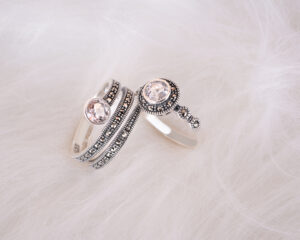
1. Stacking Rings
Stacking rings are a versatile and stylish choice for travel. They allow you to mix and match different styles, metals, and stones, creating a unique look each time. Whether you’re wearing them with a casual outfit or dressing up for an evening out, stacking rings provide an effortlessly chic look. You can adjust the number of rings depending on the occasion or your mood. Plus, stacking rings are lightweight and compact, making them perfect for packing without taking up too much space.
2. Signet Rings
Signet rings offer a bold yet timeless look that is perfect for travelers who enjoy making a statement with their jewelry. Historically associated with power and prestige, signet rings can be engraved with initials, family crests, or meaningful symbols. A signet ring adds a sophisticated touch to any outfit and is a great conversation starter. These rings are durable and practical, ideal for daily wear during your travels, especially for those who enjoy a minimalist style with a bit of flair.
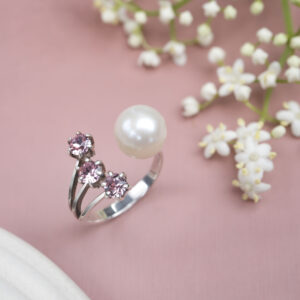
3. Statement Rings
Statement rings are an essential part of any jewelry collection, especially for travelers who want to stand out and express their personality through their accessories. Whether it’s a large gemstone, a bold design, or intricate detailing, statement rings make a strong impression. For travel, you might want to choose statement rings that are easy to wear with multiple outfits. Opt for rings with vibrant stones like turquoise or citrine, which can add a pop of color to your look without clashing with your wardrobe.
4. Adjustable Rings
Adjustable rings are perfect for travelers who want to pack light but still have a versatile piece of jewelry. These rings allow you to change the size to fit different fingers, so you don’t need to worry about sizing issues. Adjustable rings are also great if you plan on wearing the ring on different fingers throughout your trip. Choose a sleek design in a metal that complements your travel wardrobe, and you’ll have a comfortable and functional ring that works for any occasion.

5. Birthstone Rings
For those who want to carry a personal touch with them while traveling, birthstone rings are an excellent option. These rings can be customized with your own birthstone or the birthstones of loved ones, making them meaningful keepsakes. Birthstone rings can be simple or adorned with other gemstones for a more intricate design. Wearing a birthstone ring can serve as a reminder of home and your loved ones while exploring new destinations.
6. Wedding Bands
If you’re traveling with a significant other, your wedding band is likely to be one of the most important rings you’ll wear. While you can always opt for a traditional gold or platinum wedding band, there are many modern options available, including rings with diamonds, gemstones, or even alternative metals like titanium or tungsten. If you prefer something less flashy, you might want to choose a simpler design, which is both practical and understated. A wedding band is a beautiful way to honor your love, no matter where your travels take you.

7. Stackable Midi Rings
Midi rings are worn above the knuckle, and they can be styled alone or stacked for a bohemian, carefree look. These rings are great for creating a layered look without overwhelming your hands. When traveling, midi rings are perfect for day-to-night wear, and they won’t take up too much space in your luggage. You can choose a few different styles to mix and match, or go for a more minimalist look with simple metal bands.
8. Travel-Inspired Rings
Many jewelers create rings that are inspired by the destinations or cultures they visit. These travel-inspired rings often feature motifs related to specific places, such as the Eiffel Tower for Paris, palm trees for tropical getaways, or mountain peaks for outdoor adventures. Travel-inspired rings can serve as mementos of your travels and can remind you of the special experiences you had in different parts of the world.
Benefits of Wearing Rings While Traveling
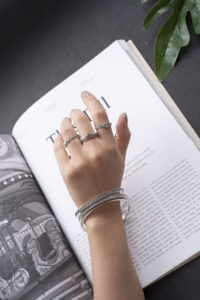
Easy to Personalize Your Style
Rings are one of the most versatile jewelry pieces, allowing you to personalize your travel style effortlessly. Whether you want to go bold or subtle, rings can complement any look, from casual outfits to more formal attire. With stacking rings, you can adjust the look depending on the occasion, and statement rings can help you express your unique style while traveling.
Space-Saving and Lightweight
Rings are compact and lightweight, making them easy to pack for your trip. They don’t take up much space in your luggage, and a few well-chosen rings can provide endless styling possibilities. Unlike bulky necklaces or bracelets, rings are a minimalistic way to accessorize without overpacking.
Convenient and Functional
Rings are practical pieces of jewelry that can be worn throughout your travels. Unlike necklaces or earrings, which may require more maintenance or attention, rings are low-maintenance accessories. Whether you’re exploring a city or relaxing at the beach, rings are simple to wear and comfortable, and they won’t interfere with daily activities.
Tips for Choosing Rings for Travel
1. Consider Durability
When traveling, it’s important to choose rings that are durable and can withstand everyday activities. Choose rings made from high-quality metals such as stainless steel, titanium, or sterling silver, which are resistant to tarnishing and scratching. If you’re heading to a beach or outdoor destination, opt for rings that are water-resistant to prevent damage from saltwater or chlorine.
2. Choose Timeless Designs
Traveling often means you’ll want to wear your jewelry with a variety of outfits. Choosing rings with timeless designs, such as simple bands or classic stones, ensures that they’ll go well with almost anything. If you’re looking to make a statement, opt for a ring with a neutral color palette that will complement different wardrobe choices.
3. Pack Multi-Use Rings
Multi-use rings are perfect for travelers who want versatility. A ring that can easily transition from day to night or can be dressed up or down will save you from packing too many accessories. For instance, a sleek stackable ring can be worn casually during the day and layered for a more sophisticated look in the evening.
4. Consider Comfort
When traveling, you want to be comfortable in your jewelry. Choose rings with smooth, rounded edges and avoid overly bulky designs that might cause discomfort during long periods of wear. Comfort is especially important for travelers who plan to be on the move for extended hours, whether exploring new destinations or going on adventure-filled activities.
Caring for Your Rings While Traveling

Clean Regularly
Traveling can expose your rings to dirt, sunscreen, and other elements that can dull their shine. To keep them looking their best, clean your rings regularly. Use a soft cloth to wipe away any residue, and for gemstone rings, use a gentle jewelry cleaner to maintain their sparkle.
Store Properly
When you’re not wearing your rings, store them safely in a travel jewelry case or individual pouches. This will prevent them from getting scratched or tangled with other jewelry. Avoid tossing them in a bag or leaving them exposed to harsh conditions.
Avoid Wearing in Risky Situations
While it’s tempting to wear your rings everywhere, there are certain situations where it’s best to leave them behind. For example, when swimming in the ocean, engaging in extreme sports, or cleaning with harsh chemicals, remove your rings to avoid damage.
DIY Travel Rings
If you’re feeling crafty, creating your own travel rings is a fun way to personalize your jewelry collection. You can create rings from wire, beads, or even stones you’ve collected from your travels. These DIY rings can serve as meaningful souvenirs, reminding you of the places and experiences you’ve had.
- Materials Needed: Wire, beads, crystals, metal bands, ring settings, jewelry glue.
- Steps:
- Select your materials and design a pattern that reflects the places you’ve visited.
- Shape the wire or beads into a ring and secure it with glue or a soldering tool.
- Allow the ring to set and adjust the size if necessary.
- Select your materials and design a pattern that reflects the places you’ve visited.
Rings are an essential accessory for travelers who want to add a personal touch to their outfits. Whether you prefer stacking rings, statement pieces, or simple bands, there are endless options to suit your style and needs. With their versatility, durability, and timeless appeal, rings can elevate any travel wardrobe while providing comfort and practicality on the go. Choose the right rings for your travels, and you’ll have stylish accessories that make every journey even more memorable.

Mastering the Art of Layering Silver Jewelry
Layering silver jewelry is a stylish way to express your personality, whether you prefer minimalist elegance or bold statement pieces. The right combination of necklaces, rings, bracelets, and earrings can enhance any outfit and create a unique, fashion-forward look. In this guide, we’ll explore how to layer silver jewelry like a pro, the best styling tips, and how to avoid common mistakes.
Mastering the Art of Layering Silver Jewelry

1. Why Layering Silver Jewelry is a Trend That’s Here to Stay
Silver jewelry has always been timeless, but layering takes it to the next level by allowing you to mix textures, lengths, and styles.marcasite jewelry.
Why It’s a Must-Try Trend:
- Creates Dimension & Depth – Adds intrigue to any outfit.
- Versatile for Any Occasion – Works for casual, business, and formal looks.
- Personalized Styling – Mix and match pieces to reflect your personal style.
2. How to Layer Silver Necklaces for the Perfect Look
When layering necklaces, the key is balancing different lengths and styles to create an effortlessly chic look.
Basic Layering Formula:
- Choker (14 inches) – The shortest layer that sits at the neck.
- Mid-Length Pendant Necklace (16-18 inches) – Adds a focal point.
- Long Statement Necklace (20+ inches) – Provides balance and elegance.
Styling Tips:
- Mix different chain styles (e.g., snake chains with link chains).
- Add a silver pendant or gemstone necklace as a centerpiece.
- Avoid tangling by choosing adjustable chain lengths.

3. Stacking Silver Rings Like a Pro
Stackable rings allow you to create a unique, customizable look while maintaining a sleek, modern aesthetic.
How to Stack Silver Rings:
- Combine thin bands with statement rings for balance.
- Use midi rings (worn above the knuckle) to add extra detail.
- Mix textures—hammered silver, twisted bands, and smooth finishes.
Styling Tips:
- Keep it simple with 3-5 rings per hand.
- Wear one bold ring on the index or middle finger for a modern touch.
- Opt for gemstone or engraved rings to add personality.
4. Layering Silver Bracelets & Bangles
Bracelet stacking can be a fun way to add personality and movement to your look.
The Perfect Bracelet Stack:
- Thin Silver Chain Bracelet – A subtle base layer.
- Chunky Cuff Bracelet – Adds structure and elegance.
- Beaded or Charm Bracelet – Introduces texture and meaning.
Styling Tips:
- Mix different widths and textures for contrast.
- Keep one wrist stacked while leaving the other simple.
- Pair with a silver watch for an effortlessly classy look.
5. Coordinating Layered Earrings
Layering doesn’t stop at necklaces and bracelets—curating multiple earrings can also make a stunning statement.
How to Layer Silver Earrings:
- If you have multiple piercings, mix studs, hoops, and ear cuffs.
- Stick to one metal tone for a cohesive look.
- Balance sizes—pair small studs with a larger focal earring.
6. Common Mistakes to Avoid When Layering Silver Jewelry
- Overloading Too Many Statement Pieces – Keep one standout piece and layer around it.
- Mixing Too Many Clashing Styles – Stick to a theme (minimalist, boho, edgy, etc.).
- Using All Thick or All Thin Pieces – Balance is key! Mix chain widths and textures.
7. Caring for Your Layered Silver Jewelry
Since layered jewelry can tangle and tarnish easily, proper care is essential.
- Store necklaces separately in anti-tarnish pouches.
- Use a silver polishing cloth to maintain shine.
- Keep delicate chains untangled by clasping them before storing.
Mastering the art of layering silver jewelry allows you to create endless style combinations. Whether you’re into delicate stacking rings, bold chain necklaces, or curated ear piercings, layering silver jewelry is the perfect way to enhance your personal style.

February’s Amethyst: Spiritual and Healing Meanings
Amethyst, the birthstone for February, is a radiant gemstone renowned for its regal purple hue and deep spiritual significance. As a member of the quartz family, amethyst has been revered throughout history as a symbol of protection, clarity, and inner peace. Its name comes from the Greek word amethystos, meaning “not intoxicated,” as it was believed to prevent drunkenness and overindulgence.
Today, amethyst is celebrated for its beauty as well as its spiritual and healing properties, making it a favorite among healers, meditators, and gem enthusiasts alike. This guide explores the many facets of amethyst’s meaning and how it can enrich your emotional, mental, and spiritual well-being.
February’s Amethyst: Spiritual and Healing Meanings
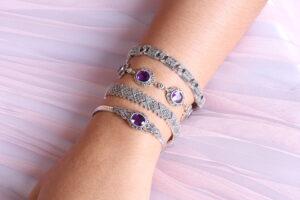
Physical and Geological Properties
- Mineral Class: Quartz
- Chemical Formula: SiO₂
- Color: Light lavender to deep violet
- Hardness: 7 on the Mohs scale
- Crystal System: Trigonal
- Luster: Vitreous
- Transparency: Transparent to translucent
Amethyst forms in geodes and volcanic rocks and can be found in Brazil, Uruguay, Zambia, and the United States. Its striking purple color is due to iron impurities and natural radiation.
Symbolic and Metaphysical Meanings
1. Spiritual Awareness and Intuition
Amethyst is known for activating the crown chakra and third eye chakra, which are associated with spiritual insight and higher consciousness. It:
- Enhances meditation and spiritual connection
- Promotes clarity of thought and intuition
- Encourages connection with the divine or higher self
2. Emotional Balance and Calm
Amethyst has a soothing energy that helps regulate emotions and foster inner peace. It is believed to:
- Reduce anxiety, fear, and sadness
- Promote emotional stability and self-awareness
- Help process grief and loss with compassion
3. Protection and Purification
In ancient times, amethyst was used as a protective talisman against negative energy and psychic attack. Today, it is used to:
- Cleanse the aura of toxic influences
- Create a protective spiritual shield
- Aid in breaking bad habits and addictive behaviors
4. Mental Clarity and Focus
Amethyst supports clear thinking and cognitive function. It can be used to:
- Improve concentration and memory
- Assist in decision-making and problem-solving
- Quiet mental chatter and promote mindfulness
Healing Benefits (Metaphysical)
Amethyst is widely used in energy healing and crystal therapy. Practitioners believe it helps:
- Alleviate headaches and insomnia
- Support the immune and endocrine systems
- Soothe inflammation and promote detoxification
- Restore energetic balance to the body and mind
Chakra Association
- Third Eye Chakra (Ajna): Stimulates intuition, wisdom, and foresight
- Crown Chakra (Sahasrara): Opens the gateway to spiritual enlightenment and divine connection
How to Use Amethyst
1. Jewelry
Wearing amethyst in rings, pendants, earrings, or bracelets allows you to carry its calming energy throughout the day. Place it close to the third eye or crown for maximum energetic impact.
2. Meditation and Spiritual Practice
- Hold an amethyst crystal while meditating to deepen awareness
- Place it on the third eye to enhance visualization and insight
- Create a crystal grid to enhance spiritual focus or healing intent
3. Sleep and Dream Work
- Keep amethyst under your pillow or near your bed to improve sleep quality
- Use during lucid dreaming or to encourage vivid and meaningful dreams
4. Home and Sacred Space
- Place amethyst clusters in your home to create a serene atmosphere
- Use in your altar or sacred space to elevate vibrations and promote harmony
Caring for Amethyst
- Cleaning: Gently rinse with warm water and mild soap; avoid harsh chemicals
- Recharging: Place under moonlight or on a bed of quartz or selenite
- Storage: Keep away from prolonged direct sunlight, which can fade its color over time
Amethyst in History and Culture
- Ancient Greece and Rome: Believed to protect against drunkenness and promote mental clarity
- Medieval Europe: Used in rosaries and religious relics; symbolized piety and humility
- Tibetan Buddhism: Revered for its spiritual properties and used in prayer beads
Throughout time, amethyst has symbolized tranquility, spiritual wisdom, and divine love. Its enduring presence in sacred traditions speaks to its powerful energetic resonance.
Amethyst is a stone of spiritual depth, emotional clarity, and serene strength. As February’s birthstone, it offers calm, protection, and a pathway to higher understanding. Whether used in meditation, worn as jewelry, or placed in your home, amethyst invites you to embrace inner peace, personal growth, and connection to the greater whole. Jewelry Amethyst.

Jade: Ancient Meanings, Colors, and Care
Jade has been revered for thousands of years for its beauty, spiritual significance, and cultural importance. Known for its smooth texture and vibrant green hues, jade is more than a decorative gemstone—it is a symbol of purity, protection, harmony, and balance. Highly valued in cultures throughout Asia, Mesoamerica, and beyond, jade remains a deeply respected and energetically rich stone.
This guide explores the different types and colors of jade, its historical and spiritual meanings, as well as practical tips for care and use. Whether used as jewelry, talismans, or in ceremonial settings, jade continues to inspire reverence and admiration across generations.
Jade: Ancient Meanings, Colors, and Care
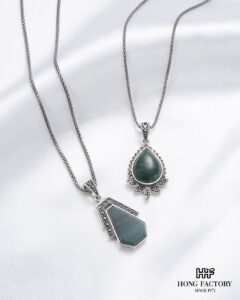
What Is Jade?
The term “jade” actually refers to two distinct but similar minerals:
- Jadeite: The rarer and more valuable variety. Jadeite exhibits a wider range of colors and greater translucency. Imperial jade, a vibrant emerald-green jadeite colored by chromium, is the most prized.
- Nephrite: More common and widely used in traditional tools and carvings. Nephrite has a fibrous texture, tends to be more durable, and is found in various shades of green, white, and brown.
Although chemically and structurally different, both jadeite and nephrite are considered true jade and have been equally valued in different cultures and time periods.
Physical Properties of Jade
- Jadeite Hardness: 6.5 to 7 on the Mohs scale
- Nephrite Hardness: 6 to 6.5
- Luster: Vitreous to waxy
- Transparency: Opaque to translucent
- Crystal System: Monoclinic (jadeite), monoclinic or fibrous (nephrite)
Jade is renowned for its toughness and resistance to breakage, especially nephrite, which was historically used to make weapons, tools, and ritual items. It can be polished to a brilliant sheen, making it ideal for fine carving and jewelry.
Cultural and Historical Significance
China
No culture has embraced jade as fully as China. For over 7,000 years, jade has been regarded as the “Stone of Heaven.” Confucius associated jade with the virtues of wisdom, compassion, and righteousness. It was used in burial suits for royalty, shaped into dragons, phoenixes, and guardian animals, and believed to connect the earthly and spiritual realms.
A famous Chinese proverb says: “Gold has a price; jade is priceless.”
Mesoamerica
In ancient Mesoamerican civilizations, such as the Maya and the Aztecs, jade was even more precious than gold. It symbolized fertility, life force, and divine connection. Jade masks, beads, and amulets were placed in tombs to accompany the dead and ensure protection in the afterlife.
Maori Culture
Among the Maori people of New Zealand, nephrite jade (called pounamu or greenstone) is considered a sacred treasure (taonga). Carved into symbolic shapes like the hei-tiki or spiral, it is passed down through generations and imbued with ancestral mana (spiritual power). It serves as a mark of identity, honor, and spiritual connection.
Other Cultures
- India: Jade is considered auspicious and is used in talismans and ceremonial tools.
- Russia and Central Asia: Nephrite was widely used in Siberia for both functional and decorative objects.
- Europe: Jade became popular during the Art Deco era, often incorporated into fine jewelry.
Metaphysical and Spiritual Meanings
1. Harmony and Balance
Jade harmonizes energy, balancing emotional, physical, and spiritual aspects of life. It calms the nervous system and stabilizes mood swings. It is often used in crystal healing to align the mind and body.
2. Protection and Luck
Jade is widely believed to offer protection against misfortune and accidents. In traditional Chinese medicine and metaphysics, jade is used as a guardian stone, worn by travelers, infants, and the elderly to ensure safety and good fortune.
3. Heart Chakra Activation
Green jade resonates strongly with the heart chakra (Anahata):
- Opens the heart to love and compassion
- Aids in forgiveness and emotional healing
- Encourages trust, empathy, and healthy relationships
It’s a perfect stone for those healing from grief, betrayal, or emotional trauma.
4. Wisdom and Tranquility
Jade’s energy supports mental clarity, patience, and thoughtful decision-making. It is considered a stone of serenity, helping users access deeper spiritual insights and remain centered in difficult situations.
5. Prosperity and Longevity
Jade is often used in manifestation practices to attract wealth, good luck, and success. It is believed to:
- Open the path to abundance
- Enhance self-sufficiency and perseverance
- Encourage long life and vitality
Jade Colors and Their Meanings
- Green Jade: Growth, health, prosperity, and fertility
- White Jade: Purity, peace, and spiritual clarity
- Lavender Jade: Emotional healing, spiritual awakening, and inner peace
- Black Jade: Protection, grounding, and strength during adversity
- Yellow/Orange Jade: Joy, optimism, and personal empowerment
- Red Jade: Vitality, courage, and life force
Each color aligns with different chakras and energetic intentions. For example, lavender jade works well with the crown chakra, while red jade stimulates the root chakra.
How to Use Jade
1. Jewelry
- Wear jade pendants, bangles, rings, or earrings for ongoing energy support.
- Jade worn on the left hand is believed to receive blessings; on the right, it projects energy outward.
2. Meditation and Energy Work
- Hold jade during meditation for calming and centering the mind.
- Place it over the heart or third eye for chakra healing and intuitive development.
3. Feng Shui and Space Clearing
- Place jade figurines, bowls, or spheres in the home or office to attract harmony and wealth.
- Use in the southeast area (wealth sector) or east (health and family) in Feng Shui placement.
4. Gifting Jade
Jade makes a meaningful and powerful gift for birthdays, anniversaries, or rites of passage. In many cultures, it is given as a gesture of protection, love, and spiritual well-being.
Caring for Jade
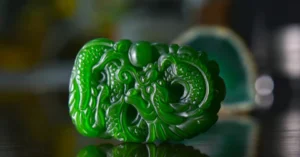
Although jade is tough, proper care is essential to preserve its beauty and energy:
Cleaning
- Use lukewarm water, mild soap, and a soft cloth or brush.
- Avoid abrasive materials that can scratch the surface.
Avoid
- Harsh chemicals like bleach or acid-based cleaners
- Prolonged exposure to direct sunlight (which can dull the luster)
- Ultrasonic or steam cleaners, which may damage the stone internally
Storage
- Store jade separately from harder gemstones (e.g., diamonds, sapphires).
- Wrap in a soft cloth or place in a lined jewelry box to avoid scratches.
Energetic Cleansing
- Cleanse under the moonlight or bury in soil overnight for energetic reset.
- Use sound (e.g., Tibetan singing bowl), smudging (e.g., sage or palo santo), or selenite plates for gentle clearing.
Jade in Modern Design and Art
- Contemporary Jewelry: Designers continue to integrate jade into modern settings, blending tradition with fashion.
- Sculpture and Carving: Master artisans craft jade into intricate designs—dragons, flowers, Buddhas—used in homes, temples, and sacred spaces.
- Decorative Objects: Bowls, seals, statues, and ceremonial items are treasured for their spiritual presence and aesthetic value.
Jade is more than a gemstone—it is a timeless symbol of harmony, healing, and the sacred connection between human and nature. Its enduring appeal across cultures is a testament to its powerful energy and natural beauty.
Whether worn as a protective charm, used in meditation, or cherished as a family heirloom, jade continues to serve as a spiritual ally and guardian of well-being. Honoring jade with intention allows its wisdom to flow into all areas of life—guiding us toward clarity, compassion, and conscious living.

Amethyst: Spiritual Benefits and Physical Properties
Amethyst is one of the most beloved and recognized crystals in the world, prized for its stunning purple hue and powerful spiritual significance. Known as a stone of peace, clarity, and divine connection, amethyst has been used for centuries in healing practices, meditation, and personal adornment. This guide explores both the metaphysical and physical aspects of amethyst, offering a complete overview of why it continues to be cherished across cultures and belief systems.
Amethyst: Spiritual Benefits and Physical Properties

What Is Amethyst?
Amethyst is a variety of quartz distinguished by its violet to deep purple coloration, which is caused by the presence of iron and natural irradiation. It is found in many parts of the world, including Brazil, Uruguay, South Korea, Russia, and the United States.
Belonging to the hexagonal crystal system, amethyst commonly forms in geodes or as crystalline clusters. It is the birthstone for February and is associated with the zodiac signs Pisces, Aquarius, and Sagittarius.
Physical Properties of Amethyst
- Mineral Family: Quartz
- Chemical Formula: SiO₂ (Silicon Dioxide)
- Color: Light violet to deep purple
- Hardness: 7 on the Mohs scale
- Luster: Vitreous (glassy)
- Transparency: Transparent to translucent
- Crystal System: Hexagonal
High-quality amethyst displays a rich, even purple color with minimal zoning. Deep tones with flashes of red or blue are particularly desirable in the gemstone market.
Spiritual and Metaphysical Benefits

Amethyst is celebrated as one of the most spiritually potent stones. Its energy resonates with serenity, protection, and divine wisdom, making it a favorite among healers, mystics, and meditators.
1. Enhances Spiritual Awareness
Amethyst is deeply connected to the crown chakra (Sahasrara), located at the top of the head. It is believed to:
- Open one’s consciousness to higher realms
- Aid in developing intuition and psychic abilities
- Support spiritual practices such as meditation, prayer, and astral travel
2. Promotes Inner Peace and Emotional Balance
Often referred to as a stone of calm, amethyst can help:
- Reduce stress and anxiety
- Soothe irritability and mood swings
- Foster emotional centering and tranquility
3. Aids in Addiction Recovery and Sobriety
Historically, the word “amethyst” comes from the Greek amethystos, meaning “not intoxicated.” Ancient Greeks wore amethyst amulets to prevent drunkenness, and the stone is still associated with:
- Overcoming addictions (alcohol, food, emotional patterns)
- Developing healthy boundaries and self-discipline
4. Encourages Restful Sleep
Placing amethyst under a pillow or near the bed is believed to:
- Ward off nightmares and insomnia
- Encourage vivid, meaningful dreams
- Promote deep and restful sleep
5. Strengthens Intuition and Mental Clarity
Amethyst helps clear mental fog and stimulates insight. It is often used to:
- Improve decision-making
- Enhance memory and concentration
- Support logical thinking while balancing intuitive flow
Chakra Connection
Amethyst is primarily associated with:
- Crown Chakra (Sahasrara): Governs spiritual connection, enlightenment, and universal consciousness.
- Third Eye Chakra (Ajna): Supports inner vision, insight, and higher wisdom.
By aligning these chakras, amethyst supports a balanced perspective and a deep sense of spiritual grounding.
Cultural and Historical Use
- Ancient Egypt: Used in protective amulets and tomb decorations.
- Greece and Rome: Believed to prevent intoxication and promote clarity.
- Middle Ages: Worn by royalty and clergy as a symbol of wisdom and divine connection.
- Tibetan Buddhism: Used in prayer beads and spiritual rituals.
Throughout history, amethyst has served as a powerful talisman of purity, humility, and sacred devotion.
How to Use Amethyst in Daily Life
- Meditation: Hold or place on the third eye during meditation to deepen your spiritual practice.
- Jewelry: Wearing amethyst as a pendant, ring, or bracelet can keep its energy close throughout the day.
- Home Decor: Place geodes or clusters in living spaces to purify the energy and create a calming atmosphere.
- Sleep Aid: Keep a small crystal near your bed or under your pillow.
- Chakra Healing: Use in reiki or energy healing sessions to balance upper chakras.
Cleansing and Charging Amethyst
To keep amethyst energetically vibrant:
- Cleanse: Use running water, sound (such as a singing bowl), or smoke from sage or palo santo.
- Charge: Place under moonlight (especially full moon) or on a selenite slab. Avoid prolonged exposure to direct sunlight, as it may fade the color.
How to Choose Quality Amethyst
When selecting an amethyst, consider:
- Color: Rich, deep purple with uniform saturation
- Clarity: Fewer inclusions and internal fractures
- Cut: Well-cut stones display brilliance and sparkle
- Origin: Brazilian and Uruguayan amethysts are considered high quality
Amethyst is much more than a beautiful gemstone—it is a deeply spiritual ally that offers protection, peace, and insight. Whether used in meditation, worn as jewelry, or simply admired for its beauty, amethyst connects the earthly and the divine. Its legacy across cultures and its enduring popularity make it a true cornerstone of holistic and metaphysical traditions.
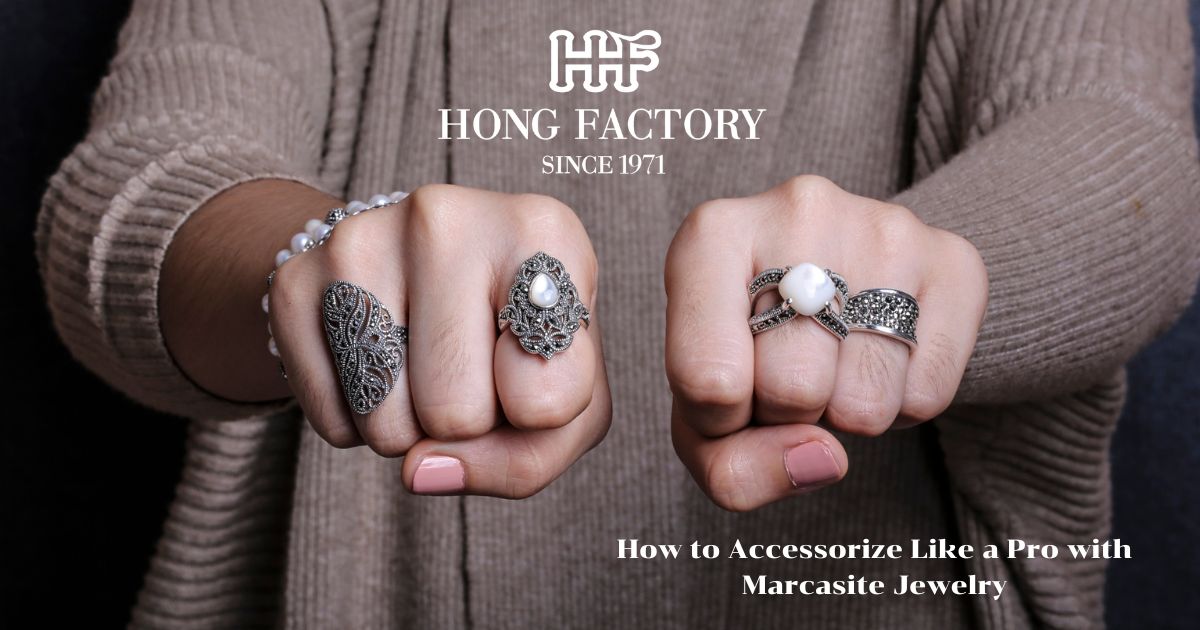
How to Accessorize Like a Pro with Marcasite Jewelry
Marcasite jewelry is beloved for its old-world charm, rich texture, and subtle metallic sheen. Whether you’re going for a glamorous evening look or smart-casual polish, mastering the art of accessorizing with marcasite will elevate your outfits with timeless elegance. This guide shares professional tips to help you wear marcasite with confidence and style.
How to Accessorize Like a Pro with Marcasite Jewelry
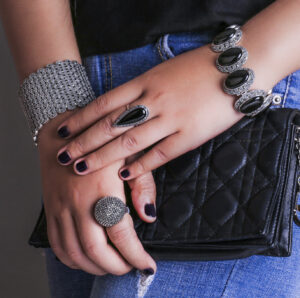
Why Marcasite Is Worth Styling
- Vintage Sophistication – Evokes Art Deco elegance and antique charm
- Neutral Metallic Hue – Complements both silver and darker color palettes
- Textural Detail – Adds interest to simple or minimalist outfits
- Day-to-Night Versatility – Works for every setting, from office to evening
Key Principles of Pro-Level Accessorizing
1. Balance Is Everything
Marcasite jewelry can be eye-catching. If you’re wearing a statement piece (like a bold necklace or large brooch), keep other accessories minimal. Let one piece do the talking.
2. Layer with Purpose

Layering works beautifully with marcasite if done thoughtfully:
- Mix marcasite pendants with fine chains
- Stack marcasite rings with plain silver bands
- Pair a marcasite cuff with a delicate bangle
3. Match Mood to Occasion
- Workwear: Stud earrings, slim ring, and a simple brooch
- Casual: Drop earrings and a marcasite charm bracelet
- Evening: Bold cocktail ring, layered necklaces, and chandelier earrings
4. Mix Modern and Vintage
Blend marcasite with contemporary elements:
- Wear a marcasite brooch on a structured blazer
- Style marcasite earrings with a sleek jumpsuit or modern blouse
- Use contrast: rough denim + ornate marcasite necklace
Outfit Pairing Ideas
1. Classic Black Dress
- Add marcasite statement earrings and a bold ring
- Finish with a clutch that has metallic accents
2. Crisp White Shirt and Jeans
- Accent with marcasite pendant necklace and stud earrings
3. Silk Blouse and Trousers
- Brooch at the collar and marcasite bangle
- Optional: Matching marcasite hairpin
4. Evening Gown
- Layered marcasite necklaces with crystal details
- Complement with chandelier earrings and a vintage-inspired ring
Tips by Jewelry Type
Earrings
- Choose size and shape based on face shape and hairstyle
- Updos and short hair highlight drop and chandelier styles
Necklaces
- V-necklines pair well with marcasite pendants
- High necklines or collars can be balanced with long chains or brooches
Rings
- Use one bold marcasite ring to anchor your look
- For everyday, pair marcasite bands with minimalist rings
Brooches
- Add to jackets, scarves, handbags, or hats
- Use symmetrical placement for formal settings
- Play with asymmetry in casual or creative looks
Caring for Marcasite Like a Pro
- Keep dry—remove before washing hands or applying lotions
- Clean gently with a soft, dry cloth
- Store separately to avoid scratches or stone loosening
Mastering the art of accessorizing with marcasite jewelry means understanding balance, choosing the right pairings, and letting your jewelry reflect both your outfit and your personality. Whether you’re channeling vintage elegance or adding flair to a modern ensemble, marcasite provides a rich, stylish touch that always feels intentional.
